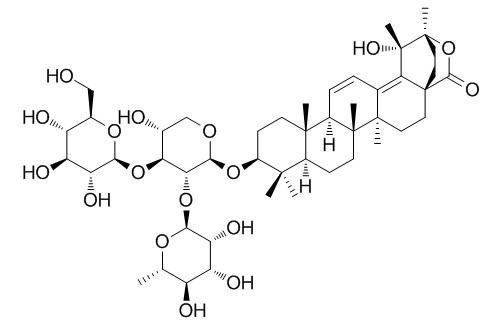Kudinoside D
Kudinoside D exerts anti-adipogenic effects through modulation of adipogenic transcription factors via AMPK signaling pathway.
Inquire / Order:
manager@chemfaces.com
Technical Inquiries:
service@chemfaces.com
Tel:
+86-27-84237783
Fax:
+86-27-84254680
Address:
1 Building, No. 83, CheCheng Rd., Wuhan Economic and Technological Development Zone, Wuhan, Hubei 430056, PRC
Providing storage is as stated on the product vial and the vial is kept tightly sealed, the product can be stored for up to
24 months(2-8C).
Wherever possible, you should prepare and use solutions on the same day. However, if you need to make up stock solutions in advance, we recommend that you store the solution as aliquots in tightly sealed vials at -20C. Generally, these will be useable for up to two weeks. Before use, and prior to opening the vial we recommend that you allow your product to equilibrate to room temperature for at least 1 hour.
Need more advice on solubility, usage and handling? Please email to: service@chemfaces.com
The packaging of the product may have turned upside down during transportation, resulting in the natural compounds adhering to the neck or cap of the vial. take the vial out of its packaging and gently shake to let the compounds fall to the bottom of the vial. for liquid products, centrifuge at 200-500 RPM to gather the liquid at the bottom of the vial. try to avoid loss or contamination during handling.
QASCF2022, 14(4).
Hong Kong Baptist University2023, 048330T.
Br J Pharmacol.2018, 175(6):902-923
Chem Res Toxicol. 2022, acs.chemrestox.2c00049.
Oxid Med Cell Longev2019, 9056845:13
Food Chem.2017, 228:301-314
Int J Mol Sci.2022, 23(20):12516.
Methods Protoc.2024, 7(6):95.
Molecules2022, 27(14):4601
Molecules.2023, 28(8):3376.
Related and Featured Products
J Food Sci. 2016 May;81(5):H1313-9.
The Hypolipidemic Effect of Total Saponins from Kuding Tea in High-Fat Diet-Induced Hyperlipidemic Mice and Its Composition Characterized by UPLC-QTOF-MS/MS.[Pubmed:
27074384]
Kuding tea are used as a traditional tea material and widely consumed in China.
METHODS AND RESULTS:
In this study, total saponins (TS) from water extract of Kuding tea was prepared by D101 macroporous resins and analyzed by UPLC-QTOF-MS/MS. Then the hypolipidemic effect of TS extract was investigated in high-fat diet-induced hyperlipidemic mice. For comprehensive identification or characterization of saponins in TS extract, 3 major saponins of Kudinoside A, Kudinoside F, and Kudinoside D were isolated and used as standards to investigate the MS/MS fragmentation pattern. As a result, 52 saponins were identified or characterized in TS extract from Kuding tea. In addition, the increased levels of mice serum TC, LDL-C, HDL-C, and atherogenic index (AI) were significantly reduced after the treatment of TS extract. Also, the liver protective effect of TS extract was obviously judged from the photographs stained with oil red-O staining. Meanwhile, TS extract significantly upregulated the expression of hepatic scavenger receptors including SR-AI, SR-BI, and CD36. Therefore, it is reasonable to assume that the overexpression of hepatic scavenger receptors was involved in the hypolipidemic effect of Kuding tea on the high-fat diet-induced hyperlipidemic mice. The TS extract could influence these scavenger receptors, and this could be the potential mechanism of TS extract from Kuding tea in the treatment of lipid disorders.
CONCLUSIONS:
These results give the evidence that the saponins in Kuding tea could provide benefits in managing hypercholesterolemia and may be a good candidate for development as a functional food and nutraceutical.
Fitoterapia. 2018 Mar;125:208-216.
Kudinoside-D, a triterpenoid saponin derived from Ilex kudingcha suppresses adipogenesis through modulation of the AMPK pathway in 3T3-L1 adipocytes.[Pubmed:
29170122]
The leaves of Ilex Kudingcha, locally named "Kudingcha" in China, has been traditionally applied for treating obesity. Studies have demonstrated that the ethanol extract of Ilex kudingcha have anti-adipogenic effects. However, the constituent which was responsible for its anti-obesity and its underlying molecular mechanism has not yet been elucidated.
METHODS AND RESULTS:
This research explored the anti-obesity effect of Kudinoside D which was a main natural component of triterpenoid saponin from the ethanol extract of Ilex kudingcha, on lipid accumulation and the potential mechanism of action of adipogenesis in 3T3-L1 adipocytes. The adipocytes were treated with various concentrations of Kudinoside D (0 to 40μM) during differentiation. The image-based Oil Red O staining analyses revealed that KD-D, dose dependently reduced cytoplasmic lipid droplet in 3T3-L1 adipocytes with the IC50 is 59.49μM. Meanwhile, major adipogenic transcription factor peroxisome proliferator-activated receptor γ (PPARγ), CCAAT/enhancer binding protein-α (C/EBPα) and sterol regulatory element-binding protein 1c (SREBP-1c) were significantly repressed as well as their target genes. The phosphorylation of AMP-activated protein kinase (AMPK) and its downstream target phosphorylated-acetyl CoA carboxylase (ACC) expression were also increased. In addition, the inhibitory effects of KD-D on the expressions of PPARγ and C/EBPα were weakened when cells were cotreated with AMPK inhibitor Compound C.
CONCLUSIONS:
These results indicated KD-D exerts anti-adipogenic effects through modulation of adipogenic transcription factors via AMPK signaling pathway. And the current findings demonstrated that KD-D was a potential therapeutic candidate for alleviating obesity and hyperlipidemia.



